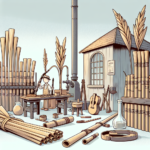If you've started playing the clarinet, you might have heard people talk about being a ‘reed geek.' This friendly nickname shows just how much some players care about their reeds. In this guide, we'll take a closer look at clarinet reeds, their different types, and how they change your sound. Whether you're new to the clarinet or have been playing for years, knowing about reeds will help you play better and get the sound you want.
The Basics of Clarinet Reeds
A clarinet reed is a thin piece of cane that makes sound when you blow air over it. Clarinets use single reeds, unlike oboes which use double reeds. You attach the reed to the mouthpiece with a ligature. Reeds come in different strengths, widths, and shapes, and these differences affect how your clarinet sounds.
Types of Clarinet Reeds
Knowing about the different kinds of clarinet reeds can help you choose the right one. Here are the main types:
- French Cut: These reeds are made in a special way that gives a rich, warm sound. Many orchestra players like them because of their unique tone.
- American Cut: These reeds are more blunt than French cut and make a brighter sound. Jazz players often prefer them because they work well for different styles of music.
- File Cut: These reeds are made thinner to be more flexible. Experienced players who know exactly what they want from their reeds often use this type.
- Hard Rubber or Plastic Reeds: Some players choose these man-made reeds because they last longer and work more consistently. They handle temperature changes better than cane reeds but might not sound as natural.
| Reed Type | Sound Characteristics | Preferred By |
|---|---|---|
| French Cut | Rich and warm tone | Orchestral musicians |
| American Cut | Brighter sound | Jazz musicians |
| File Cut | More flexible | Advanced players |
| Hard Rubber/Plastic | Consistent, durable | Players seeking consistency |
Reed Strengths and Selection
Reeds are usually sorted by strength, which changes how hard it is to play. The scale usually goes from 1 to 5, with 1 being the softest and 5 being the hardest.
Choosing the Right Strength: Picking the right reed strength depends on how you play, what kind of mouthpiece you have, and what feels comfortable to you. Beginners often start with softer reeds (around 2 to 2.5) because they're easier to play. More experienced players might like stronger reeds (3 to 4) because they offer more control.
Trying Different Reeds
If you're really into reeds, don't be shy about trying different brands and strengths until you find one you like. Everyone plays differently, so what works for one person might not work for another. It's a good idea to visit a music store and try out several options to find what suits you best. Keep notes on which reeds work well for you in different situations, like when you're performing or warming up.
Maintaining Your Clarinet Reeds
Taking care of your reeds can make them last longer and sound better. Here are some important tips:
- Soaking: Wet your reed for about 30 seconds before you play. This makes the cane more flexible and helps it sound better. But be careful not to soak it for too long, or it might warp.
- Storage: Use a special reed holder that controls moisture. This helps your reeds keep their shape and quality.
- Regular Rotation: Use several reeds and switch between them. If you always use the same reed, it will wear out faster and might not play as well.
- Sanitation: Clean your mouthpiece and ligature often. This prevents buildup that could affect how your reed works and how you play.
Advanced Techniques for Reed Adjustments
As you learn more about reeds, you might want to try these advanced methods to make your reeds work even better for you:
- Trimming the Tip: If your reed feels too hard to play, you can carefully trim the tip. Use a sharp knife or a special reed trimmer to make small changes, and test it as you go.
- Shaping and Sanding: You can also change the shape of your reeds by sanding them. Be careful though, because too much sanding can make the reed lose quality.
- Marking Your Reeds: Use a pencil to mark your reeds when you make changes or find something you like. This can help you make the same changes again in the future.
By learning about your reed, taking good care of it, and making small changes, you can really improve how you play the clarinet. If you keep practicing and trying new things, you'll find that knowing how to work with your reeds helps you get a richer, warmer sound that lets your music shine.







